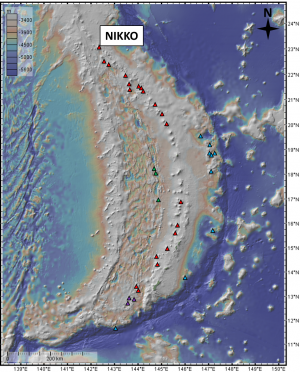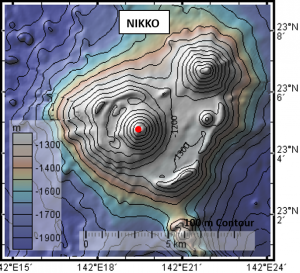
Nikko Vent


Latitude: 23.08ºN Longitude: 142.325ºE Depth: 460 m bsl
Vent sites*: Naraku, Varnum (InterRidge Vents Database Ver. 3.3)
Nikko seamount hosts one of the world’s largest hydrothermal systems (Pala, 2009). The volcano is unusual because it is part of the active Mariana arc (N. Seamount Province) but is also where the Mariana Trough backarc basin extension axis intersects the arc in the north. Nikko has the morphology of a resurgent caldera (Resing et. al., 2009). The summit of Nikko has pools of molten sulfur (Embley et al., 2007; Nakamura et al., 2009). The associated hydrothermal plume is characterized by elevated concentrations of total dissolved Fe and Mn which indicates that these plumes issue from high T vents (Resing et. al, 2009). Plumes are also rich in CO2, 3He and H2S (Resing et.al, 2009). The biological of community is dominated by decapod crustaceans such as Austinograea yunohana (Takeda et al., 2000) and some microbes such as Epsilonproteobacteria (Huber et al., 2010).
Table 1: Operations history for Nikko Vent
| Ship/ Platform | Operation | Year | Dive Number | References |
| MGLN02MV R/V Melville/ ROV Jason-2 | CTD tow-yo; CTD vertical cast; SeaBeam 2000 multibeam | 2006
April– May |
J2-198 – J2-199 | Submarine Ring of Fire, 2006
Woods Hole Oceanographic Institution: ROV JASON/MEDEA: Operations Summary (note: click “Files- operations summary”) |
| NT10-13 Natsushima Leg.2/ Hyper-dolphin | Not found | 2010
July – August |
HPD#1163 HPD#1164 HPD#1168 HPD#1169 HPD#1165 | NT10-13 leg2 cruise report |
| TN-153 R/V T.G. Thompson | EM 300 multibeam; CTD tow-yo | 2003 February – March | Not found | Submarine Ring of Fire, 2003 |
Table 2: Vent activity and host rocks
| Activity and host rocks | References | |
| Activity | Active volcano,
last erupted 1974 |
Smithsonian Global Volcanism Program |
| Host Rocks | Basalt and Dacite | Bloomer et al., 1989 |
Table 3: Plume Characteristics
| Parameter | References | |
| Temperature (ºC) | High T 61-112; >200 | Resing et al., 2009; Lupton et al.,2008; Embley et al., 2007 |
| pH | 5.05-6.21 | Huber et al., 2010 |
| ΔpH | -0.160 | Resing et al., 2009 |
| Composition | Rich in CO2, ³He, H2S, S, Sulfates and total dissolved Fe and Mn | Lupton et al., 2008 |
| CO2 (mM) | 3.53-96.5 | Resing et al., 2009 |
| ΔCO2 (mM) | 43 | Lupton et al., 2008 |
| H2 (mM) | 0.0006-0.0396 | Resing et al., 2009 |
| Particulate Fe (nmol/kg) | 502 | Huber et al., 2010 |
* ΔpH, ΔCO2 – Measured relative to the regional background.
Table 4: Vent Biology
| General name | Phylum | Order | Family | Species | References |
| Bacteria | Proteobacteria | Epsilonproteobacteria | Thiofractor thiocaminus | Huber et al., 2010
Makita et al., 2012 |
|
| Crab | Arthropoda | Decapoda | Bythograeidae | Austinograea yunohana (Gandalfus yunohana) | *Takeda et al., 2000
Yorisue et al., 2012 |
| Barnacles | Arthropoda | Sessilia | Neoverrucidae | Neoverrcuca sp. | Yorisue et al., 2012 |
| Crab | Arthropoda | Decapoda | Xanthidae | Yorisue et al., 2012 | |
| Crab | Arthropoda | Decapoda | Parapaguridae | Paragiopagurus ventilatus | Komai et al., 2010 |
| Shrimp | Arthropoda | Decapoda | Alvinocaridae | Alvinocaris sp. | Yorisue et al., 2012 |
| Shrimp | Arthropoda | Decapoda | Alvinocarididae | Opaepele sp. | Tsuchida et al. 2002
Miyake et al., 2007 |
| Tube Worms | Annelida | Polychaeta | Siboglinidae | Lamellibrachia satsuma (trophosome) | Black et al, 1997
Kojima et al., 2012 Hashimoto et al. 1993
|
| Tube Worms | Annelida | Polychaeta | Siboglinidae | Lamellibrachia satsuma (muscle) | Black et al, 1997
Kojima et al. 2012 Yorisue et al., 2012 |
| Scale Worms | Annelida | Polycheata | Polynoidae | Branchinotogluma
burkensis Branchinotogluma marianus |
*Pettibone, 1989
Kojima et al., 2015 |
| Mussels | Mollusca | Bivalvia | Mytilidae | Gigantidas sp. | Kyuno et al., 2009 |
| Snails | Mollusca | Gastropoda | Phenacolepadidae | Shinkailepas sp. | Yorisue et al., 2012 |
| Turrids | Mollusca | Gastropoda | Turridae | Oenopota ogasawarana | Yorisue et al., 2012 |
| Tonguefish | Osteichthyes | Actinopterygii | Cynoglossidae | Symphurus thermophylus |
Tunnicliffe et al., 2010 Munroe et al., 2008 |
Images:
- Small chimneys on the floor of Nikko caldera. The venting is so prolific that the smoke often impedes visibility on the sea floor.
- There is so much sulfur being produced at Nikko that volcanic rocks are only rarely exposed. The sea floor in the summit crater is mostly covered by lush bushes of tubeworms in association with white crabs, flatfish, and shrimps.
- One fish seems to thrive around the hydrothermal vents of the Mariana volcanoes. At Daikoku and Nikko volcanoes tonguefish and crabs cover the sea floor in some areas.
- These are four tonguefish samples from Nikko volcano. The fish at Nikko are almost twice as big as their counterparts on Daikoku. The largest sample here is less than 11 cm (5 in) long.
Videos:
- The Nikko volcano has numerous hydrothermal vents, an extraordinary biomass, and marine life.
- The crater floor at Nikko has many sulfur chimneys, both active and inactive.
- The south rim of the summit crater at Nikko is covered by an amazing density of tubeworms.
- The south slope of the summit cone at Nikko was found to contain a large area with boiling pots of molten sulfur.
- Closer examination of the area around the molten sulfur pots reveals that what appears to be solid ground is just a thin crust on a larger lake of molten sulfur!
- When the Jason II remotely operated vehicle tries to sample a rock, it sinks through the thin crust on a lake of molten sulfur!
References:
- Black, M. B., Halanych, K. M., Mass, P. A. Y., Hoeh, W.R., Hashimoto, J., Desbruyères, D., Lutz, R. A., Vrijenhoek, R. C., 1997. Molecular systematic of vestimetiferan tubeworms from hydrothermal vents and cold-water seeps. Marine Biology 130, 141–149.
- Bloomer, S. H., Stern, R. J., Fisk, E., Geschwind, C. H., 1989. Shoshonitic Volcanism in the Northern Mariana Arc. 1. Mineralogic and Major and Trace Element Characteristics. Journal of Geophysical Research 94 (B4), 4469-4496.
- Embley, R. W., Baker, E. T., Butterfield, D. A., Chadwick, W. W. Jr., Lupton, J. E., Resing, J. A., de Ronde, C. E. J., Nakamura, K., Tunnicliffe, V., Dower, J. F., Merle, S. G., 2007. Exploring the submarine ring of fire: Mariana Arc- Western Pacific, Oceanography 20, 68–79.
- Hashimoto J., Miura T., Fujikura K., Ossaka J., 1993. Discovery of vestimentiferan tube-worms in the euphotic zone. Zoological Science, 10, 1063–1067.
- Huber, J. A., Cantin, H. V., Huse, S. M., Welch, D. B., Sogin, M. L., Butterfield, D. A., 2010. Isolated communities of Epsilonproteobacteria in hydrothermal vent fluids of the Mariana Arc seamounts: FEMS Microbiol Ecol. 73 (3), 538-549.
- Kojima, S., Watanabe, H., 2015. Vent Fauna in the Mariana Trough. In: Ishibashi, J., Okino, K., Sunamura, M. (Eds.), Subseafloor Biosphere Linked to Hydrothermal Systems: TAIGA Concept. Springer Japan, 313-323.
- Kojima S, Murakami S, Nemoto S, Watanabe H, Miyake H, Tsuchida S., 2012. Genetic diversity and population structure of a vestimentiferan annelid Lamellibrachia satsuma in Japanese and northern Mariana waters. Plankton Benthos Res 7, 146–150.
- Komai, O., Kitajima, M., Nemoto, S., Miyake, H., 2010. New record of Paragiopagurus ventilates (Crustacea: Decapoda: Anomura: Parapaguridae) from hydrothermal vents on the Nikko Seamount, Mariana Trough, the first hermit crab using siboglinid tubes for housing. Marine Biodiversity Records 3, 1- 8.
- Kyuno, A., Shintaku, M., Fujita, Y., Matsumoto, H., Utsumi, M., Watanabe, H., Fujiwara, Y., Miyazaki, J., 2009. Dispersal and Differentiation of Deep-Sea Mussels of the Genus Bathymodiolus (Mytilidae, Bathymodiolinae). Journal of Marine Biology 2009, 1-15.
- Lupton, J., Lilley, M., Butterfield, D., Evans, L., Embley, R., Massoth, G., Christenson, B., Nakamura, K., Schmidt, M., 2008. Venting of a separate CO2-rich gas phase from submarine arc volcanoes: Examples from the Mariana and Tonga-Kermadec arcs. Journal of Geophysical Research 113 (B8), 1-21.
- Makita, H., Nakagawa, S., Miyazaki, M., Nakamura, K., Inagaki, F., Takai, K., 2012. Thiofractor thiocaminus gen. nov., sp. nov., a novel hydrogen-oxidizing, sulfur-reducing epsilonproteobacterium isolated from a deep-sea hydrothermal vent chimney in the Nikko Seamount Weld of the northern Mariana Arc. Arch Microbiol 194, 785–794.
- Miyake, H., Kitada, M., Tsuchida, S., Okuyama, Y., Nakamura, K., 2007. Ecological aspects of hydrothermal vent animals in captivity at atmospheric pressure. Marine Ecology. 28 (1), 1–241.
- Munroe, T. A., Hashimoto, J., 2008. New Western Pacific Tonguefish (Pleuronectiformes: Cynoglossidae): The first Pleuronectiform discovered at active Hydrothermal Vents. Zootaxa 1839, 43–59.
- Pala, C., 2009. The Pacific Ocean’s Acidification. Environmental Science and Technology 43, 6451–6452.
- Pettibone, M. H., 1989. New species of scale-worms (Polychaeta: Polynoidae) from the hydrothermal rift-area of the Mariana Back-Arc Basin in the western central Pacific. Proc Biol Soc Wash 102, 137–153.
- Resing, J. A., Baker, E. T., Lupton, J. E., Walker, S. L., Butterfield, D. A., Massoth, G. J., Nakamura, K., 2009. Chemistry of hydrothermal plumes above submarine volcanoes of the Mariana Arc. Geochemistry, Geophysics, Geosystems 10 (2), 1-23.
- Takeda, M., Hashimoto, J., Ohta, S., 2000. A new species of the family Bythograeidae (Crustacea, Decapoda, Brachyura) from the hydrothermal vents along volcanic front of the Philippine Sea Plate. Bulletin of the National Science Museum,Tokyo, series A, Zoology 26 (4), 159–172.
- Tunnicliffe, V., Koop, B. F., Tyler, J., So, S., 2010. Flatfish at seamount hydrothermal vents show strong genetic divergence between volcanic arcs. Marine Ecology 31, 158–167.
- Yorisue, T., Inoue, K., Miyake, H., Kojima, S., 2012. Trophic structure of hydrothermal vent communities at Myojin Knoll and Nikko Seamount in the northwestern Pacific: Implications for photosynthesis-derived food supply. Plankton Benthos Res 7(2), 35–40.
Website References:
- InterRidge Vents Database Ver. 3.3; http://vents-data.interridge.org/ventfield/nikko-volcano (accessed 11/24/2015)
- Smithsonian Global Volcanism Program http://volcano.si.edu/volcano.cfm?vn=284132 (accessed 11/24/2015)
- Woods Hole Oceanographic Institution: ROV JASON/MEDEA: Operations Summary; http://www.whoi.edu/main/jason/operations-summary (accessed 11/24/2015)
- Submarine Ring of Fire 2006 http://oceanexplorer.noaa.gov/explorations/06fire/logs/may12/may12.html (accessed 11/24/2015)
Cruise Reports:
- NT10-13 leg2 cruise report http://www.godac.jamstec.go.jp/catalog/data/doc_catalog/media/NT10-13_leg2_all.pdf (accessed 11/24/2015)
- Submarine Ring of Fire 2006 http://oceanexplorer.noaa.gov/explorations/06fire/logs/summary/media/srof06_cruisereport_final.pdf (accessed 11/24/2015)
- Submarine Ring of Fire 2003 http://oceanexplorer.noaa.gov/explorations/03fire/logs/summary/marianas_cruisereport.pdf (accessed 11/24/2015)

